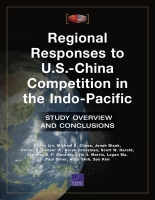In long-term strategic competition with China, how effectively the United States works with allies and partners will be critical to determining U.S. success. To enable closer cooperation, the United States will need to understand how allies and partners view the United States and China and how they are responding to U.S.-China competition.
In this report, which is the main report of a series on U.S.-China competition in the Indo-Pacific, the authors define what U.S.-China competition for influence involves and comparatively assess U.S.-China competition for influence in six countries in Southeast Asia—Indonesia, Malaysia, the Philippines, Singapore, Thailand, and Vietnam—as well as the roles of three U.S. allies and partners that are active in Southeast Asia—Australia, India, and Japan. The authors first explore why the United States is competing with China in the Indo-Pacific and what the two are competing for. They then develop a framework that uses 14 variables to assess relative U.S.-Chinese influence across countries in the Indo-Pacific. Drawing from interviews in all nine countries and data gathered, the authors apply this framework to assess how regional countries view U.S.-China competition in their respective countries and how China views competition in each of the regional countries. Finally, the authors discuss how the United States could work more effectively with allies and partners in Southeast Asia and beyond.
Key Findings
The United States and China have different strengths and approaches to competition
Regional countries view the United States as having more diplomatic and military influence than China, and China as having more economic influence.
Southeast Asian countries rank economic development over security concerns and are generally more worried about Chinese economic influence than Chinese military threats.
China can leverage its economic influence for a variety of goals, including to weaken U.S. military influence. In contrast, there is no evidence that Association of Southeast Asian Nations countries believe that U.S. military influence serves as a counterweight against Chinese economic influence.
Regional countries have more shared interests with the United States, but Beijing has more tools it is willing to use against Southeast Asia, including more incentives ("carrots") and coercive capacity ("sticks").
Regional countries prefer to not choose between the United States or China and may not side with the United States if forced to pick. Partner alignment is likely to be weak and incomplete.
The United States could work more effectively with allies and partners
While direct, bilateral cooperation should remain the primary effort, the United States should do more to coordinate with Australia, India, and Japan in Southeast Asia.
Coordinating with allies and partners to engage third countries provides four main benefits to the United States: Coordination (1) pools resources, (2) facilitates division of labor that leverages unique allied and partner strengths and relationships, (3) counters PRC influence in countries with which the United States cannot fully engage, and (4) achieves U.S. objectives without asking regional countries to explicitly align themselves with the United States (which regional countries are wary of doing).
There are five main challenges to effective coordination: (1) government biases and processes favor bilateral efforts instead of cooperation in engaging third countries; (2) the dominant narrative portrays U.S.-China competition in bilateral terms and does not take into account allied and partner contributions; (3) regional countries seek unique and separate relationships with the United States, and there are divergences in interests between the United States, allies, and partners; (4) Chinese influence in allies and partners could undermine their ability and willingness to coordinate with the United States; and (5) differing U.S., allied, and partner planning and budget cycles complicate efforts to develop coordinated or joint plans.
Recommendations
Develop a list of U.S. objectives and priority countries for competition with China for each region (including the Indo-Pacific) to enable whole-of-government competition.
Develop targeted nonmilitary means to counter Chinese economic influence in the Indo-Pacific.
Improve public messaging on the economic benefits and value that U.S. military and security cooperation bring to regional countries.
Improve U.S. public messaging on U.S.-China competition by increasing messaging on allied and partner contributions and combined efforts.
Increase defense activities with Indonesia, Malaysia, Thailand, and Vietnam, four countries in which Chinese influence is growing.
Establish a minimum requirement within the Department of Defense to consult and share U.S. engagement objectives, plans, and activities in the Indo-Pacific with Australia, India, and Japan.
Expand institution capacity building efforts to deepen shared security interests.
Avoid framing activities with regional countries mainly in U.S.-China competition terms; consider creative ways to design engagements to achieve similar objectives while avoiding the optics of requiring the partner to choose between the United States or China.
Initiate a pilot project to develop common five-year security cooperation plans between the U.S. Air Force and the Royal Australian Air Force for Indonesia or Malaysia and between the U.S. Air Force and the Japan Air Self-Defense Force for the Philippines or Vietnam.
Encourage Indonesia to increase its military activities in the South China Sea and areas such as the Natunas by conducting operations and participating in multilateral air and maritime activities.
Propose new avenues of U.S. Air Force engagement with Malaysia through its membership in the Five Power Defense Arrangements.
In Thailand, strive to maintain preferential access and use of U-Tapao—one of the largest airfields in Southeast Asia.
Leverage senior U.S. engagements with the Vietnamese Ministry of National Defense to emphasize the importance of routinizing service-to-service cooperation.
For Australia, develop options to expand the Enhanced Air Cooperation component of the Force Posture Initiatives and consider conducting rotational deployments of U.S. Air Force bombers to northern Australia.

No comments:
Post a Comment